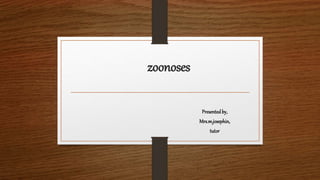
chn.pptx
- 2. introduction • ZOONOSIS derived from the Greek words • • Zoon- Animal & Noson – Disease • • Zoonoses was coined and first used by Rudolf Virchow who defined it for communicable diseases • • Diseases and infections which are naturally transmitted between vertebrate animals and humans - WHO 1959
- 3. • of the 415 microbial diseases affecting humans, 61% are zoonotic with 13% species regarded as emerging or reemerging. • • Link b/w human & animals with their surrounding are very close especially in developing countries. • • Emerging zoonosis as “a zoonosis that is newly recognized or newly evolved, or that has occurred previously but shows an increase in incidence or expansion in geographical, host or vector range”- WHO/FAO/OIE joint consultation, May 2004
- 4. Emerging diseases • Hanta virus in USA • Avian influenza • Bovine Spongiform Encephalitis (BSE) • Nipah virus.
- 5. Factors influencing Emerging diseases • Emergence of Zoonotic Diseases • Etiological changes in mans environment and agricultural operations e.g. Leptospirosis, plague, Rift Valley fever, Kyasanur Forest Disease etc. • Increased movement or traveling of man e.g. amoebiasis, giardiasis, colibacillosis, salmonellosis, SAARS, Yellow fever etc. • Handling animal by products and waste e.g. anthrax, chlamydiosis, dermatophytosis, tularaemia • Increased in density of animal population e.g. dermatophytosis, tuberculosis etc.
- 6. Etiological agent • Bacterial zoonoses e.g. anthrax, brucellosis, plague, leptospirosis, salmonellosis, lyme disease • Viral zoonoses e.g. rabies, arbovirus infections, KFD, yellow fever, influenza • Rickettsial zoonoses e.g. murine typhus, tick typhus, scrub typhus, Q- fever • Protozoal zoonoses e.g. toxoplasmosis, trypanosomiasis, leishmaniasis • Helminthic zoonoses e.g. echinococcosis (hydatid disease), taeniasis, schistosomiasis,dracunculiasis • Fungal zoonoses e.g. deep mycosis - histoplasmosis, cryptococcosis, superficial dermatophytes. • Ectoparasites e.g. scabies, myiasis
- 7. Mode of transmission • Direct zoonoses- From an infected vertebrate host to a susceptible host (man) by direct contact, by contact or thru fomite e.g. rabies, anthrax, brucellosis, leptospirosis, toxoplasmosis. • • Cyclozoonoses - Require more than one vertebrate host species, but no invertebrate host for the completion of the life cycle of the agent, e.g. echinococcosis, taeniasis.
- 8. • • Metazoonoses - Transmitted biologically by invertebrate vectors, in which the agent multiplies and/or develops & there is always an extrinsic incubation (prepatent) period before transmission to another vertebrate host e.g., plague, arbovirus infections, schistosomiasis, leishmaniasis. • • Saprozoonoses -Require a vertebrate host & a non-animal developmental site like soil, plant material, pigeon dropping etc. for the development of the infectious agent e.g. aspergillosis, coccidioidomycosis, cryptococosis, histoplasmosis, zygomycosis
- 9. Reserviour host • • Anthropozoonoses – Diseases in animals that can be transmitted to man e.g. rabies, leptospirosis, plague, arboviral Infcn , brucellosis and Q-fever. • • Zooanthroponoses - Infections transmitted from man to lower vertebrate animals e.g. streptococci, staphylococci, diphtheria, enterobacteriaceae, human tuberculosis in cattle and parrots. • • Amphixenoses – Infections with a bacteria maintained in both man and lower vertebrate animals and transmitted in either direction e.g. salmonellosis, staphylococcosis
- 10. • Euzoonoses : Diseases in which humans are an obligatory host of the agent Taenia solium T. saginata
- 11. Zoonoses – viral
- 12. RABIES INTRODUCTION Rabies is a fatal disease that attacks the nervous system. All warm – blooded animals, including humans, are at the risk of infection with rabies virus. Exposures most often occur as a result of contact with domestic animals like dogs, cats, horses, or castle
- 13. Epidemiological traid AGENT LYSSAVIRUS -I HOST ADULTS, CHILD ENVIRON MENT STREET DOGS IN ONE AREA
- 15. Clinical sign Tingling sensation at site of the bite
- 16. Intolerance of noise Intolerance of light
- 18. Increased reflex Muscle spasm
- 20. As the disease advances • Irritability • Confusion • Anger • Depression • Double vision • Swallowing is difficult because of the muscle spasm • Convulsions • Paralysis and Coma
- 21. diagnosis • History of bite • Clinical manifestations, behavioural symptoms-hydrophobia • Antigen using immune-fluorescence of skin biopsy • Isolation of virus from saliva.
- 22. First aid treatment • Wash the wound and scratches under a running tap water • Apply over-the counter antibiotic cream, alcohol/tincture iodine to inactivate the left over virus after wash. • bite wound should not be sutured immediately . If suturing is necessary it is done after 24-48 hours under the cover of anti rabies serum locally.
- 24. vaccine • Fourth dose • Third dose • Second dose • First dose 0day 3rd day 14th day 7th day Booster dose 28th day
- 25. Control measures for animals • Must get the registration and licensing done for all domestic dogs. • Practice restraint of dogs in public places. • Immediate destruction of dogs and cats bitten by rabid animals. • Quarantine all the imported dogs for 6 months. • Health educate people on the care of dogs and prevention of rabies.
